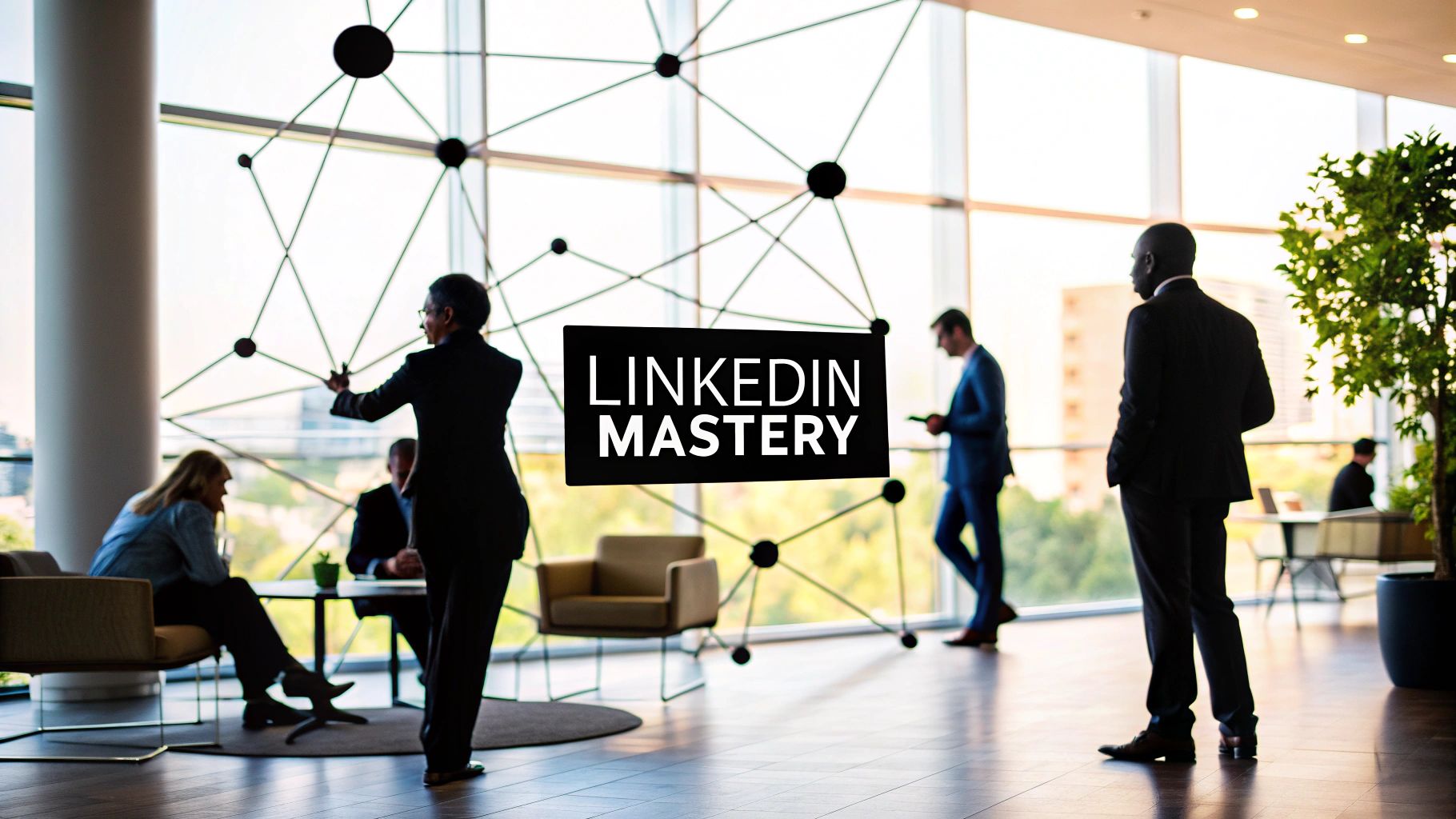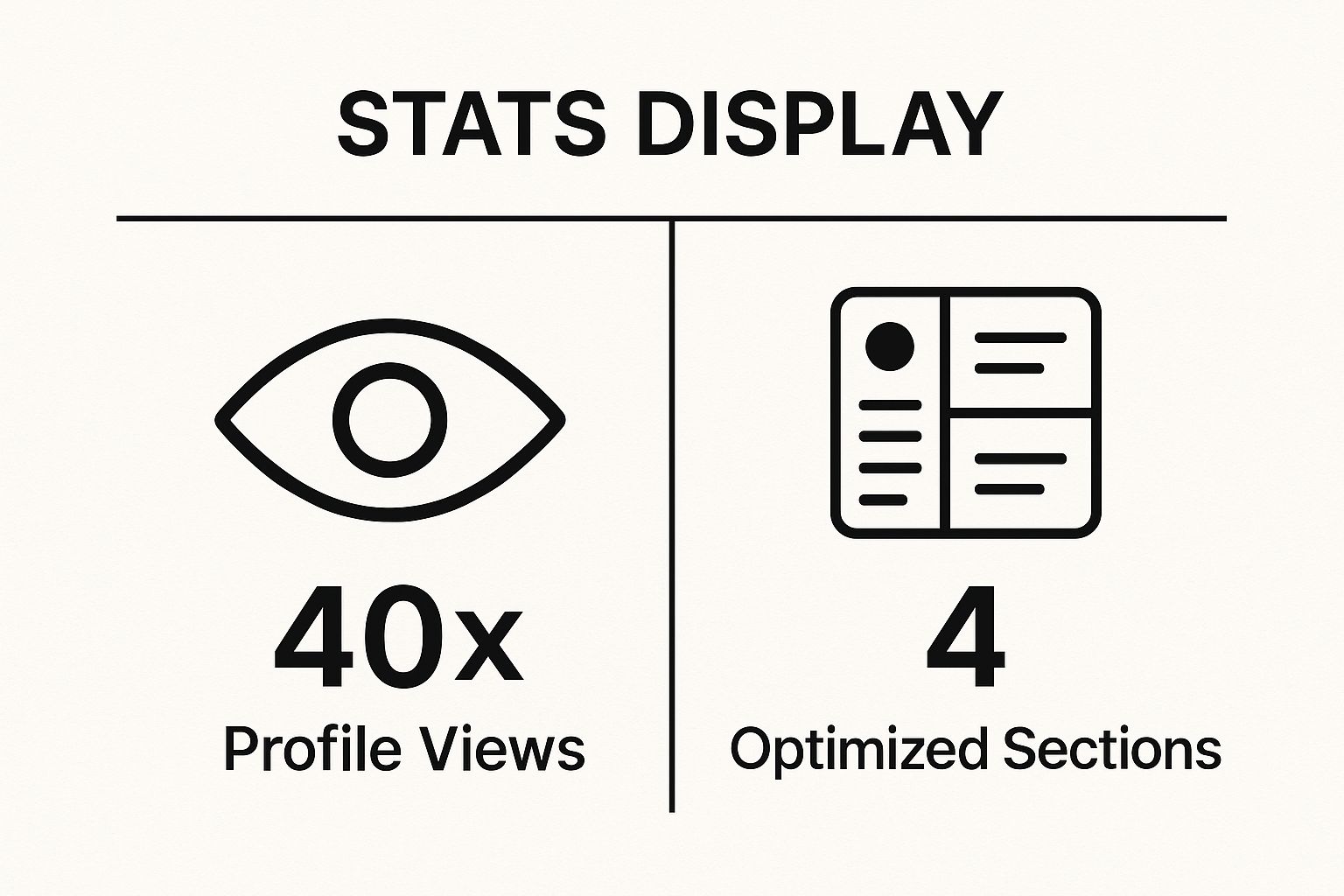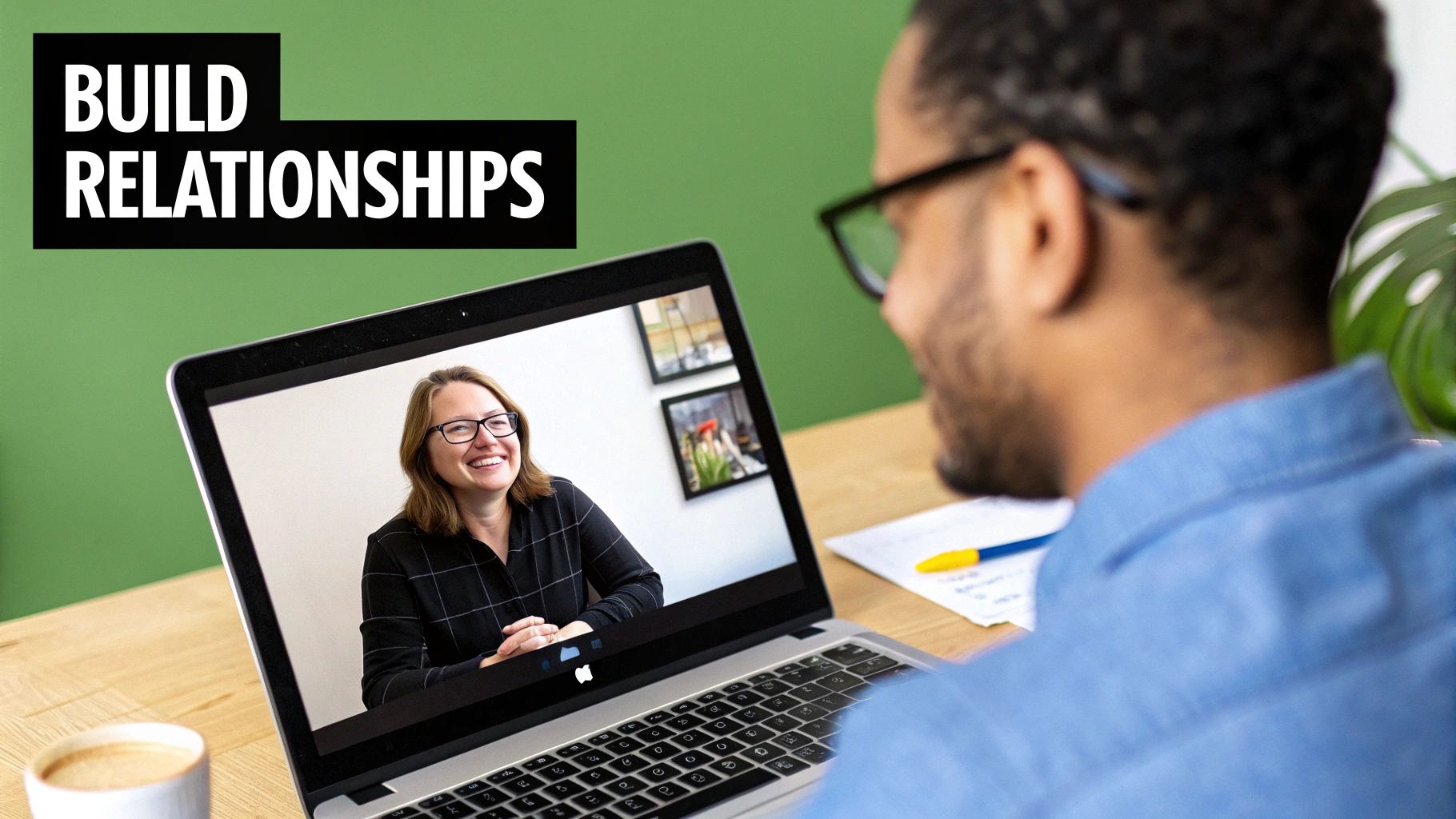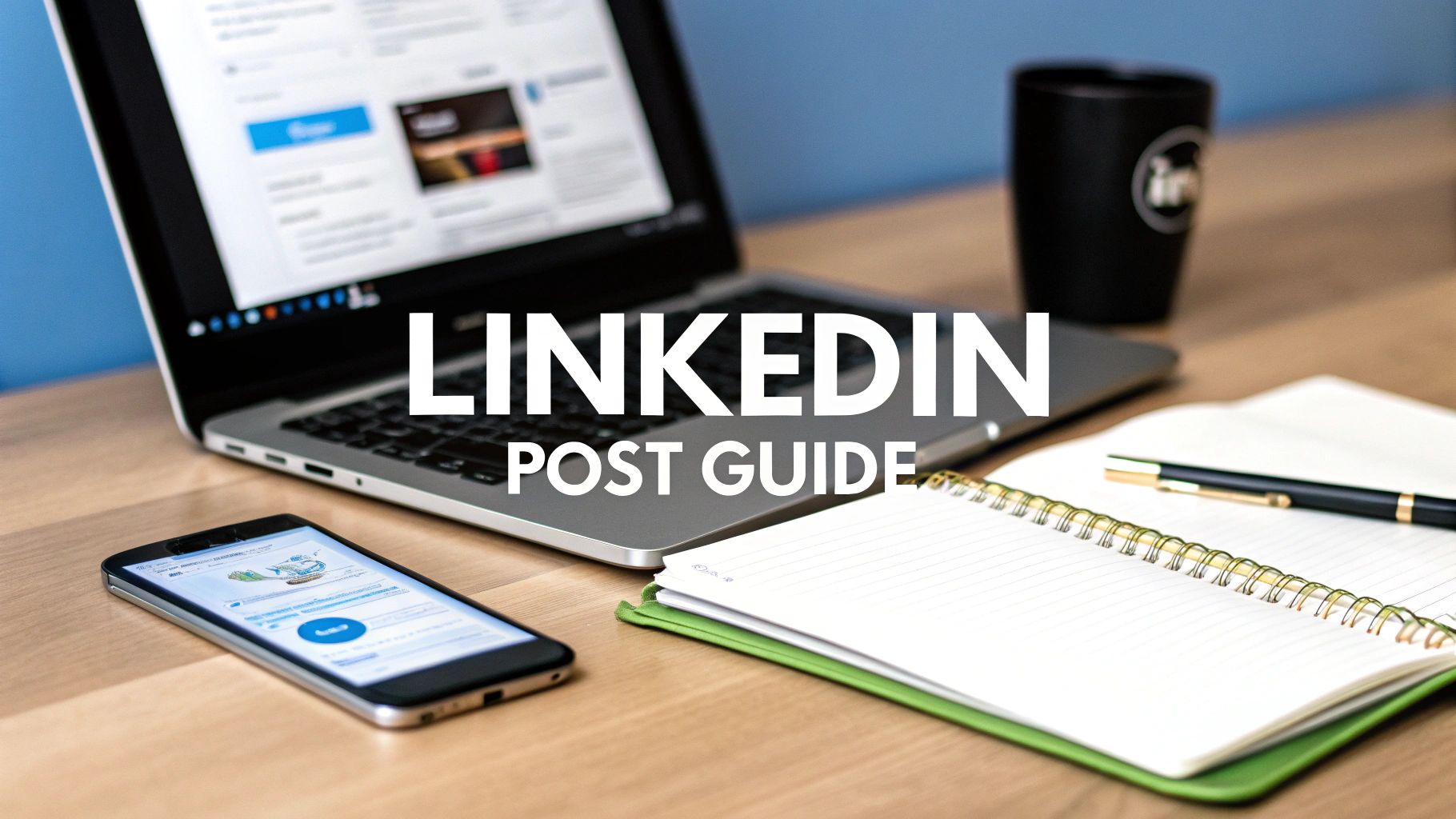
8 Best Practices on LinkedIn to Master in 2025
In the professional world, LinkedIn has evolved far beyond a simple digital resume. It is now a powerful ecosystem for career growth, lead generation, and building a professional brand. Simply maintaining a profile is no longer sufficient to make an impact. To truly stand out and achieve specific goals, whether it's attracting new clients, securing a better role, or establishing yourself as a thought leader, a deliberate and strategic approach is essential. The platform's algorithm and the sheer volume of content require a sophisticated understanding of what truly works.
This guide moves past generic advice to deliver a comprehensive roundup of eight critical, field-tested best practices on LinkedIn. Each point is designed to be immediately actionable, helping you transform your presence from a passive digital footprint into an active, high-performing asset. These practices are interconnected, forming a holistic framework for professional branding and networking. To truly unlock your LinkedIn potential, it's also helpful to explore winning personal brand strategy examples to inspire and refine your own professional identity.
We will cover the proven strategies that help you optimize every facet of your profile, create content that resonates deeply with your target audience, and build a valuable network that drives tangible, measurable results. Let's explore the methods that will elevate your professional presence and help you achieve your most ambitious goals on the platform.
1. Optimize Your LinkedIn Profile with Strategic Keywords
Think of your LinkedIn profile as a digital billboard. If it doesn't use the right language, your target audience, recruiters, and potential clients will drive right past it. Strategic keyword optimization is the practice of embedding relevant industry terms, skills, and job-related phrases throughout your profile. This is one of the most fundamental best practices on LinkedIn because it directly impacts your visibility in search results.
When a recruiter searches for a "Senior Product Manager with SaaS and B2B experience," LinkedIn’s algorithm scans profiles for those exact terms. By integrating these keywords, you ensure your profile appears in relevant searches, connecting you with the right opportunities. This process involves more than just listing skills; it's about weaving keywords naturally into your narrative to clearly communicate your value and expertise. Specifically, if your goal is career advancement, understanding how to optimize your LinkedIn profile for job search is paramount.
How to Implement Keyword Optimization
The key is to place keywords where they have the most impact. Start by analyzing job descriptions for roles you aspire to hold and identify recurring terms.
- Headline: Your headline is prime real estate. Instead of just your job title, enrich it with top keywords. For example, a software engineer could use: "Senior Software Engineer | Python, Machine Learning, Cloud Architecture | Building Scalable AI Solutions."
- Summary (About Section): Use this space to tell your professional story, incorporating keywords naturally. A digital marketer might discuss their experience driving growth through "SEO," "PPC campaigns," and "conversion optimization."
- Experience Section: In each role description, use bullet points to highlight accomplishments using action verbs and relevant keywords. For instance: "Managed a $500k PPC budget, achieving a 150% ROI through targeted ad copy and A/B testing."
- Skills Section: Add at least five core skills and seek endorsements. This not only adds keywords but also provides social proof of your capabilities.
The data below highlights how profoundly keyword optimization can impact your profile's performance.

These statistics underscore a clear message: a well-optimized profile doesn't just exist, it actively works for you, dramatically increasing your visibility and reach.
2. Publish Valuable, Original Content Consistently
Your LinkedIn profile is more than a resume; it's a dynamic platform for showcasing your expertise. Publishing valuable, original content transforms your profile from a static document into an active hub of industry insight. This practice involves consistently sharing articles, professional experiences, and commentary that educates and engages your network. This is one of the most impactful best practices on LinkedIn because it establishes you as a thought leader and keeps you top-of-mind with your audience.
When you regularly share content, you demonstrate your deep understanding of your field and your passion for your work. This attracts followers, sparks conversations, and signals to recruiters and potential clients that you are an active, authoritative voice in your industry. Rather than just listing your skills, you are actively proving them. Mastering the art of content creation is essential for this, and understanding how to write compelling LinkedIn posts is a critical step in building your professional brand.
How to Implement a Content Strategy
The goal is to provide genuine value, not just to post for the sake of it. A strong content strategy is built on relevance, consistency, and engagement.
- Maintain a Consistent Schedule: Aim to post at least 2-3 times per week. Consistency trains the LinkedIn algorithm to show your content more frequently and builds anticipation within your network.
- Use Storytelling: Frame your professional insights within a personal narrative. Share a challenge you overcame, a lesson you learned from a project, or a unique perspective on a recent industry trend. This makes your content more relatable and memorable.
- Drive Engagement: End your posts with a question to encourage comments. For example, after sharing an analysis, ask, "What trends are you seeing in your sector?" This turns your post into a conversation starter.
- Balance Your Content Mix: Share a variety of content types, including text-only posts, articles, polls, and videos. Blend professional insights (like a market analysis) with personal experiences (like your journey to a new role) to create a well-rounded and authentic professional brand.
3. Build Genuine Relationships Through Strategic Networking
Many users treat LinkedIn as a digital Rolodex, focusing on collecting as many connections as possible. However, the true power of the platform lies in building genuine, mutually beneficial relationships. Strategic networking prioritizes quality over quantity, focusing on personalized outreach and consistent engagement to cultivate a strong, supportive professional circle. This is one of the most impactful best practices on LinkedIn because it transforms a passive list of contacts into an active network of advocates, mentors, and collaborators.
A large but unengaged network offers little value. In contrast, a smaller, highly engaged network can open doors to new opportunities, provide valuable insights, and offer support when you need it most. By moving beyond transactional interactions and investing in authentic connections, you build social capital. This approach, advocated by networking experts like Keith Ferrazzi, ensures your network is not just big, but powerful. For those looking to expand their reach, understanding how to grow your LinkedIn following through authentic engagement is a key first step.

How to Implement Strategic Networking
Building real relationships requires a thoughtful, consistent approach. The goal is to be memorable, helpful, and authentic in every interaction.
- Personalize Every Connection Request: Never use the default "I'd like to add you to my professional network" message. Reference a shared experience, a mutual connection, or a piece of their content you appreciated. For example: "Hi [Name], I really enjoyed your recent post on AI in marketing. Your insights on predictive analytics were fascinating, and I'd love to connect and follow your work."
- Offer Value Before Asking for It: The foundation of any strong relationship is reciprocity. Look for opportunities to help your connections. This could mean introducing two people who could benefit from knowing each other, sharing a resource relevant to their work, or offering your expertise on a problem they’ve mentioned.
- Maintain Relationships Proactively: Don't just connect and forget. Set aside time each week to engage with your network. Congratulate people on work anniversaries and new roles, comment thoughtfully on their posts, and check in with a personal message from time to time.
- Take Conversations Offline: When appropriate, suggest a virtual coffee chat or a brief phone call. A 15-minute conversation can build more rapport than dozens of online interactions, solidifying the professional relationship.
This strategic approach ensures your networking efforts result in a robust and supportive community that actively contributes to your professional growth and success.
4. Engage Authentically with Your Network's Content
Merely being present on LinkedIn is not enough; active participation is where the real value lies. Authentic engagement is the practice of meaningfully interacting with your network's content through thoughtful comments, shares, and reactions. This moves you from a passive observer to an active community member, building genuine relationships and increasing your visibility across the platform. This is one of the most critical best practices on LinkedIn because it humanizes your professional brand and fosters reciprocity.
When you consistently add value to conversations, you become known as a knowledgeable and engaged professional in your field. The platform’s algorithm rewards this activity by showing your profile and content to a wider audience, amplifying your reach far beyond your own posts. Authentic engagement isn't about generic comments like "Great post!" but about contributing insights, asking questions, and creating real dialogue. It's the digital equivalent of a powerful networking conversation, building rapport and professional credibility with every interaction.
How to Implement Authentic Engagement
The goal is to be a value-adder, not just a content consumer. This means focusing on quality interactions that spark further discussion and demonstrate your expertise.
- Write Thoughtful Comments: Instead of a simple thumbs-up, leave a detailed comment that adds to the conversation. For example, on a post about AI in marketing, you could add: "This is a great point on data privacy. I've found that using transparent AI models helps build customer trust and improves campaign adoption rates."
- Share with Insight: When you share someone else's article or post, don't just hit the share button. Add your own perspective or a key takeaway in the description. Frame it with context like, "A must-read article on the future of remote work. The point about asynchronous communication is particularly relevant for global teams."
- Personalize Congratulations: When a connection gets a new job or promotion, go beyond the default "Congrats!" message. Mention something specific, such as: "Congratulations on the new role as Director of Sales, John! Your expertise in scaling SaaS teams makes you a perfect fit for this."
- Ask Open-Ended Questions: Encourage dialogue by asking follow-up questions in your comments. This not only shows you've read the post carefully but also invites the original poster and others to continue the conversation, boosting the post's visibility and your own.
5. Leverage LinkedIn Analytics for Data-Driven Optimization
Posting content on LinkedIn without tracking its performance is like navigating without a map. You might be moving, but you have no idea if you're heading in the right direction. Leveraging LinkedIn analytics is the practice of using data to understand what resonates with your audience, refine your strategy, and maximize your impact. This data-driven approach is one of the most critical best practices on LinkedIn because it transforms guesswork into a calculated strategy for growth.
By analyzing key metrics, you can identify which topics generate the most engagement, when your audience is most active, and who is viewing your profile. For a business owner, this means discovering which posts drive the most qualified leads. For a job seeker, it means understanding which activities lead to more recruiter views. This feedback loop allows for continuous improvement, ensuring your efforts on the platform yield tangible results. A deep understanding of analytics is also crucial if you want to measure your social media ROI effectively and justify your time investment.
How to Implement a Data-Driven Strategy
Start by regularly visiting the "Analytics" section on your profile or company page. This dashboard provides a wealth of information about your posts, audience, and profile views.
- Track Post Performance: Pay attention to impressions, reactions, comments, and clicks for each post. Identify patterns. Do posts with questions get more comments? Do video posts get more shares? A content creator might notice that short-form videos explaining industry trends outperform text-only updates, prompting a shift in their content calendar.
- Analyze Your Audience: The "Follower analytics" tab reveals the demographics of your audience, including their job titles, industries, and locations. Use this information to tailor your content to be more relevant and valuable to the people you want to reach.
- Monitor Profile Views: For professionals focused on networking or job searching, tracking "Who's viewed your profile" is invaluable. A sudden spike in views from recruiters at a target company after you've applied or networked can be a strong signal of interest.
- A/B Test Your Content: Use analytics to test different variables. Post the same type of content at different times of the day or on different days of the week to find your optimal posting schedule. Experiment with various formats like polls, carousels, and articles to see what your audience prefers.
6. Showcase Expertise Through LinkedIn Learning and Skills
Your skills are the currency of your professional value, but simply listing them isn't enough. To truly stand out, you need to provide tangible proof of your competencies. Showcasing your expertise through LinkedIn Learning completions, certifications, and skill endorsements transforms your profile from a simple resume into a dynamic portfolio of your capabilities. This is a critical one of the best practices on LinkedIn because it validates your claims and demonstrates a proactive commitment to professional growth.
When a hiring manager or potential client evaluates your profile, verified skills and certifications act as powerful trust signals. They see not only what you say you can do, but also the evidence backed by LinkedIn's platform and your professional network. This practice adds layers of credibility that a simple list of skills cannot match, proving you are dedicated to staying current in your field and continuously honing your craft.
How to Implement Skills Showcase
Effectively showcasing your skills involves a multi-pronged approach that leverages LinkedIn's built-in features to their fullest potential. Start by identifying the core competencies for your target roles and build your strategy from there.
- Complete and Feature LinkedIn Learning Courses: Identify courses relevant to your career path. Upon completion, add the certificate to your profile. This signals to your network that you are actively investing in your development and mastering new, in-demand skills.
- Add and Prioritize Your Skills: Curate your Skills section to reflect your most valuable and relevant abilities. Pin your top three skills to the top so they are immediately visible to profile visitors. For instance, a marketing professional might pin "Google Analytics," "SEO," and "Content Strategy."
- Seek Strategic Endorsements: Don't just wait for endorsements; actively seek them. Ask a manager who oversaw a specific project to endorse you for the skills used, or a colleague you collaborated with to validate your technical abilities. This adds powerful social proof.
- Showcase Formal Certifications: Add industry-recognized certifications, like a PMP for project managers or HubSpot for marketers, to the "Licenses & Certifications" section. This provides verified, third-party validation of your expertise.
- Prune Irrelevant Skills: Regularly review and remove outdated or less relevant skills. A profile cluttered with obsolete technologies or basic skills can dilute the impact of your more advanced competencies. Keep it focused and current.
7. Utilize LinkedIn's Advanced Search and Sales Navigator Features
Simply waiting for opportunities to find you on LinkedIn is a passive strategy. To truly unlock the platform's potential for networking and lead generation, you must proactively seek out the right people and companies. Utilizing LinkedIn's advanced search functions and premium tools like Sales Navigator transforms the platform from a simple social network into a powerful prospecting and research engine. This is a critical one of the best practices on LinkedIn for anyone in sales, recruiting, or business development looking to build a targeted and effective pipeline.
Instead of generic searches, these tools allow you to apply layers of specific filters, such as industry, company size, seniority level, and even keywords mentioned in profiles. For sales professionals, this means pinpointing key decision-makers within target accounts. For job seekers, it’s about identifying hiring managers at dream companies. By moving beyond basic search, you can efficiently cut through the noise and connect directly with the individuals who are most relevant to your goals, saving immense time and effort.
How to Implement Advanced Search and Sales Navigator
The goal is to move from broad, hopeful searches to precise, strategic ones. This requires a methodical approach to filtering and a clear understanding of who you want to find.
- Master Boolean Search: Use operators like AND, OR, and NOT in the main search bar to create highly specific queries. For example, "Marketing Director" AND "SaaS" NOT "Entry-Level" will narrow down your results to senior professionals in the software industry.
- Leverage Advanced Filters: On the search results page, click "All filters" to access a wealth of options. You can filter by school, current company, specific service categories, and more to refine your list of prospects or potential connections.
- Embrace Sales Navigator: If you are serious about lead generation, Sales Navigator is a worthy investment. Use its advanced lead and account filters, create custom lists, and set up alerts for when your saved leads change jobs or post content. For instance, a consultant can create a lead list of "VPs of Operations" in the "Logistics" industry at companies with 500-1,000 employees.
- Save Your Searches: Whether using free advanced search or Sales Navigator, save your most effective search criteria. LinkedIn will then notify you when new profiles match your filters, automating your prospecting and ensuring you never miss a new opportunity.
8. Maintain Professional Consistency Across All Interactions
Think of your professional brand as a promise. Consistency across your LinkedIn presence ensures that every interaction, from your profile picture to your direct messages, reinforces that promise. Maintaining professional consistency means ensuring your voice, visual identity, and communication style are cohesive across all your LinkedIn activities. This is one of the most crucial best practices on LinkedIn because it builds trust, reinforces credibility, and makes your personal brand memorable.
When your content, comments, and profile all tell the same professional story, you create a seamless and reliable experience for your network. A financial advisor who posts analytical, data-driven content while their profile headline emphasizes creative, out-of-the-box thinking sends a mixed message. Consistency eliminates this confusion, ensuring that connections, recruiters, and clients understand exactly who you are and what value you offer.
How to Implement Professional Consistency
The goal is to create a unified professional identity. This requires a deliberate strategy that aligns all aspects of your LinkedIn presence.
- Define Your Brand Voice: Decide on the tone and style that best represents your professional persona. Are you authoritative and analytical, or are you creative and collaborative? Document this and apply it to every piece of content, comment, and message you write.
- Synchronize Your Visuals: Use the same professional headshot across LinkedIn, your personal website, and other professional platforms. If you use a banner image, ensure its design, color palette, and messaging align with your overall brand identity.
- Align Content with Expertise: Ensure the articles you share, the posts you create, and the comments you leave are all relevant to the expertise you claim in your headline and summary. A project manager should focus on topics like Agile methodologies, team leadership, and productivity tools.
- Audit Regularly: Once a quarter, review your profile, recent activity, and featured section. Check for any inconsistencies in messaging, tone, or visual presentation. Promptly update your profile when your role, responsibilities, or professional focus changes.
By maintaining this consistency, you build a strong, recognizable, and trustworthy professional brand that works for you even when you're offline. It transforms your profile from a simple resume into a dynamic and coherent representation of your professional value.
Comparing the 8 LinkedIn Best Practices
Here’s a breakdown of how the eight key strategies compare, helping you prioritize where to focus your efforts based on your goals.
Optimize Profile with Keywords:
- Complexity: Low to Moderate. Requires initial research but is a one-time setup with occasional updates.
- Resources: Low. Primarily an investment of your time.
- Outcome: Essential for visibility. It’s the foundation that ensures you’re found by the right people, with potential for up to 40x more profile views.
- Best for: All professionals, especially job seekers.
Publish Original Content:
- Complexity: High. Requires ongoing creativity, research, and scheduling.
- Resources: High. Significant time commitment is needed to create quality content.
- Outcome: Builds authority and establishes you as a thought leader in your niche.
- Best for: Industry experts, consultants, and business leaders.
Build Genuine Relationships:
- Complexity: Moderate to High. Requires consistent, personalized outreach and follow-up.
- Resources: Moderate to High. A consistent time investment is crucial for nurturing connections.
- Outcome: Creates a strong, supportive network that can lead to referrals and collaborations.
- Best for: Sales professionals, business developers, and anyone in a relationship-driven field.
Engage Authentically:
- Complexity: Moderate to High. Requires daily commitment to find relevant posts and add thoughtful comments.
- Resources: High. Depends on consistent daily engagement rather than large blocks of time.
- Outcome: Increases your visibility and strengthens relationships by adding value to others' content.
- Best for: Community builders and professionals looking to expand their influence.
Leverage Analytics:
- Complexity: Moderate. Involves learning to interpret data and adjust your strategy accordingly.
- Resources: Moderate. Requires regular check-ins to monitor performance metrics.
- Outcome: Optimizes your efforts by providing clear insights into what works and what doesn't.
- Best for: Marketers, content creators, and data-driven professionals.
Showcase Skills and Learning:
- Complexity: Low to Moderate. Involves completing courses and curating your skills section.
- Resources: Moderate. May involve costs for courses and certifications.
- Outcome: Provides social proof and third-party validation of your expertise.
- Best for: Professionals in fast-changing industries and those needing to verify specific competencies.
Utilize Advanced Search:
- Complexity: High. Requires mastering Boolean logic and premium tools like Sales Navigator.
- Resources: Moderate to High. Sales Navigator is a paid tool.
- Outcome: Enables highly targeted prospecting and efficient networking.
- Best for: Recruiters, sales teams, and anyone needing to find specific decision-makers.
Maintain Professional Consistency:
- Complexity: Moderate. Requires defining your brand and performing regular audits.
- Resources: Moderate. An ongoing effort to ensure all activities are aligned.
- Outcome: Builds a strong, memorable, and trustworthy personal brand.
- Best for: Executives, consultants, and all professionals focused on long-term brand building.
From Strategy to Success: Your Next Steps on LinkedIn
You've just navigated a comprehensive roadmap detailing the most effective best practices on LinkedIn. This journey has taken you from the foundational necessity of a keyword-rich profile to the advanced strategies of data-driven optimization and authentic network engagement. We've explored how consistent, high-value content serves as your professional beacon, how genuine interaction builds lasting relationships, and how tools like LinkedIn Analytics and Sales Navigator can transform your approach from guesswork to a calculated strategy.
The power of these eight pillars lies not in their individual application, but in their synergistic integration. Think of them as interconnected gears in a powerful engine. A perfectly optimized profile attracts the right audience, but it's your consistent, insightful content that keeps them engaged. Similarly, strategic networking opens doors to new connections, but it's your authentic comments and contributions that build the trust required to walk through them. Mastering these practices means moving beyond a simple "checklist" mentality and adopting a holistic, dynamic approach to your professional presence.
The Core Takeaway: Consistency is Your Competitive Advantage
If there is one single thread that ties all these best practices on LinkedIn together, it is consistency. Sporadic bursts of activity will yield sporadic results. True influence and tangible outcomes, whether it's lead generation, career opportunities, or thought leadership, are cultivated over time through deliberate, repeated action.
- Consistent Optimization: Your profile isn't a "set it and forget it" document. Revisit your keywords and skills quarterly to align with evolving industry trends and personal goals.
- Consistent Content: Establish a realistic publishing cadence you can maintain. Whether it's three times a week or once a day, consistency builds audience expectation and algorithm favor.
- Consistent Engagement: Dedicate 15-20 minutes each day to thoughtfully engage with your network. This daily habit is far more impactful than a two-hour session once a week.
- Consistent Analysis: Regularly review your analytics. Make it a monthly ritual to check what's working, identify patterns, and refine your strategy for the upcoming month.
This commitment to consistency is what separates passive users from power players. It transforms your LinkedIn presence from a digital resume into a dynamic platform for growth, opportunity, and influence. The value is undeniable: a stronger personal brand, a more engaged and relevant network, and a direct line to the opportunities that will define the next stage of your career or business.
Your Action Plan for LinkedIn Mastery
To translate this knowledge into tangible results, don't try to implement everything at once. Instead, focus on a structured, phased approach. Here are your immediate next steps:
- Conduct a Profile Audit (This Week): Start with Pillar 1. Review your headline, summary, and experience sections. Are they packed with relevant keywords? Does your banner image communicate your value proposition? Make these foundational changes first.
- Develop a Content Calendar (Next Week): Based on Pillar 2, brainstorm three core themes you can consistently speak about. Plan your first four posts. Focus on providing value, not just promoting yourself.
- Initiate Strategic Engagement (Daily): Begin implementing Pillar 3 and 4 immediately. Identify 10 key influencers or prospects in your field. Make a conscious effort to leave a meaningful comment on at least one of their posts each day.
By breaking down these best practices on LinkedIn into manageable actions, you build momentum. Each small, consistent effort compounds over time, building a formidable professional presence that works for you even when you're offline. The journey to becoming a LinkedIn authority is a marathon, not a sprint, and it begins with these deliberate first steps. You now have the blueprint; the next move is yours.
Ready to supercharge your content creation and ensure every post makes an impact? Yooz AI helps you generate proven, high-engagement LinkedIn posts in seconds, taking the guesswork out of what resonates with your audience. Start creating smarter, not harder, by visiting Yooz AI today.









